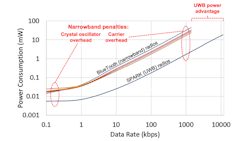What’s the Difference Between Bluetooth and UWB for High-Speed Data and Multimedia?
Members can download this article in PDF format.
What you’ll learn:
- A comparison of Bluetooth and UWB for positioning.
- Benefits of UWB for high-speed data and multimedia communications.
- The differences between Bluetooth and UWB for gaming, audio, and IoT applications.
Bluetooth and ultra-wideband (UWB) short-range wireless technologies both rose to prominence at the turn of the century, and their development paths have been driven by the unrelenting need to reduce power consumption and extend battery life for an endless proliferation of wirelessly connected devices.
Bluetooth Low Energy (BLE) was ratified in 2006 to address the early power-consumption deficiencies of Bluetooth. More recently, Bluetooth 5.2 added features to reduce consumption for targeted applications like audio. However, these modifications are strictly incremental. Fundamentally, reductions in power consumption are physically limited by the Bluetooth architecture—a carrier-based transceiver will always require a significant amount of power to start, stabilize, and maintain its RF oscillator.
The figure shows the two significant power penalties inherent to all narrowband radio architectures, including Bluetooth.
First, crystal oscillator overhead (lower left) cripples low data-rate performance. Bluetooth uses a ~20-MHz crystal oscillator, which requires a few milliwatts to power. When efficiently optimized, UWB radios can operate with impulses that don’t require a high-frequency crystal oscillator and can be designed to operate with a low timing power-consumption overhead. Much depends on the UWB optimization technique, though, so this is an area that should draw scrutiny.
Many of today’s UWB technology implementations must in fact use higher-frequency crystal oscillators than what’s required for BLE. Meanwhile, advanced UWB implementations can utilize crystal oscillators down to 32-kHz timing.
Second, the modulated carrier overhead (upper middle in the chart above) penalizes high data-rate performance. Transmitting a large amount of data over a narrow bandwidth channel such as that used in Bluetooth radios requires lots of time and power.
Large amounts of data can be transmitted with UWB far more quickly because it’s spread across a wide bandwidth, keeping the transmitter on for a much shorter duration and significantly reducing power consumption. This means for the same amount of consumed power, UWB can transmit much more data (far upper right).
This owes to the time-frequency duality, well encapsulated by the Fourier transform. In simple terms, this duality states that if you have an infinitely long periodic time signal, it will have an infinitely small bandwidth. On the other hand, if you have an infinitely short impulse signal, it will have an infinitely large bandwidth. In other words, you can trade time for bandwidth.
Ultra-wideband enjoys a clear inherent advantage over narrowband given its allocation and support over a large portion of radio spectrum. A UWB signal is defined as a signal having a spectrum larger than 500 MHz. In the United States, the Federal Communications Commission (FCC) in 2002 authorized the unlicensed use of UWB in the frequency range from 3.1 to 10.6 GHz.
UWB systems use short-duration (i.e., nanosecond timescale) electromagnetic pulses for high-speed transmission and reception of data over large bandwidths. They also have a very low duty cycle, which is defined as the ratio of the time that an impulse is present to the total transmission time.
Bluetooth vs. UWB for Positioning
After two decades of maturation, Bluetooth today is nearly ubiquitous in the battery-powered wireless-device market, spanning smartphones/tablets, earphones/headsets, gaming peripherals, IoT sensors, and more. For wireless apps that could get by with high latency and highly compressed audio signals, Bluetooth has delivered an acceptable user experience for some wireless apps. However, it could be argued that Bluetooth has reached its point of diminishing returns.
Today, UWB is emerging as a compelling successor to Bluetooth/BLE for the next generation of low-power short-range wireless applications. Consumer electronics manufacturers like Apple, Samsung, and others sure to follow are leveraging UWB spectrum for the delivery of electromagnetic impulses for applications like positioning for object/asset tracking, as exemplified by Apple’s AirTags. This is a narrow application of UWB’s technology potential, but nonetheless an effective one.
In this capacity, UWB measures time of flight (ToF): an impulse is sent from one device to another, and we measure the time it took from transmit to receive. The distance between objects is determined accordingly, and this can be measured with picosecond accuracy with UWB chips. Leveraging onboard antennas, measurements are then able to be correlated to determine a signal’s angle of arrival, and UWB “tagged” objects can consequently be located with accuracy down to a mere 10 cm.
Bluetooth technology comes nowhere close to matching this precision, as it utilizes received signal strength (RSS) to measure spatial distance. RSS is a very simple technique to implement and can be used by any wireless transceiver, which explains why it’s so widely used. However, it’s severely limited in its accuracy: The perceived distance between two immobile objects will change according to obstacles in their direct path, and BLE typically achieves positioning accuracy only to within several meters.
Positioning technology enabled with UWB—while extremely accurate—is exceedingly complex from a design perspective and therefore extremely power hungry. As a result, UWB chips used today for object tracking are actually less power-efficient than Bluetooth chips/radios by as much as 10X. So, while UWB is well-suited for positioning, it’s a power-intensive application by nature and at the end of the day, there’s no device-level power benefit delivered with UWB.
UWB for High-Speed Data and Multimedia Communication
The aforementioned time-frequency duality expresses how time and bandwidth are interchangeable. If one wants to compress in time a wireless transmission, it requires more frequency bandwidth. This property can be used to increase the accuracy of positioning and ranging, but these capabilities represent a mere sliver of UWB’s potential.
Another very interesting capability enabled by the time-frequency duality is that it can reduce the latency in systems. This has huge implications for untold short-range wireless applications into the future.
Impulses delivered over ultra-wide bandwidth ensure extremely low latency—these signals can be sent in microseconds with UWB, whereas Bluetooth would take milliseconds. The end result is ultra-efficient wireless data communication. What’s more, UWB implementations have demonstrated at least 10X less power consumption than BLE for non-positioning applications.
Bluetooth’s latency penalties will only persist for applications like gaming, audio, and IoT, which is the chief reason why wired connectivity has lingered so stubbornly for peripherals and sensors used in these applications. We welcome the freedom of mobility that wireless affords us, but historically it’s cost us quite a bit in terms of latency/delays, signal degradation, and battery drain.
Gaming
For gaming, speed is everything when it comes to outperforming one’s opponents, and latency is therefore a major concern among die-hard gamers. When gamers press the mouse button, they want an instantaneous response, but Bluetooth can only deliver response speeds of 20 to 30 ms at best.
Leveraging UWB connectivity, SPARK has demonstrated sub-0.2-ms latency for UWB wireless gaming peripherals, and the company is well along the path to achieving sub-0.1 ms. This is far beyond what Bluetooth can do, and it’s even faster than what many commercially available USB-wired mice can deliver today.
Audio
For audio, since Bluetooth is limited to a very narrow bandwidth, audio data compression must be applied to squeeze an otherwise bulky audio signal through a narrow pipe, which degrades the signal. Bluetooth codecs are inherently lossy in that lots of source audio data is stripped away. CD-quality audio is achieved with a 1,411-kb/s data rate—a Bluetooth codec renders that down to about 300 kb/s to be able to fit the audio stream within Bluetooth’s limited data-rate capabilities.
UWB enables 10X more data throughput than BLE; thus, there’s no need to compress the audio signal for wireless delivery to your UWB headset. This ensures that the sound stage one can hear with UWB headsets is considerably more detailed than what’s possible with Bluetooth today, and exactly faithful to the audio source. These benefits extend to live music performance as well—UWB liberates performing musicians from cumbersome cables without sacrificing latency, allowing for wireless live performances.
IoT
The battery life of wireless sensors and devices is insufficient today for many IoT applications, leading to overly frequent recharge cycles, limited connectivity, and bulky batteries and/or costly maintenance. In addition, long latency makes wireless inadequate in applications requiring real-time sensing and communications.
With UWB, huge volumes of sensor data can be delivered with 60X lower latency and 40X better energy efficiency than legacy Bluetooth. This is hugely beneficial not only to IoT applications, but also to the myriad smart building, smart city, and AI-guided applications on the horizon that will require ultra-high-speed communication among sprawling networks of battery-powered wireless sensors.
Bluetooth technology is well-entrenched today and has served us reasonably well for the last two decades. However, UWB’s stark latency and power-efficiency advantages position it as a compelling alternative for any wireless application requiring more data to flow faster and more freely with minimal power consumption. Everywhere Bluetooth resides today—across untold commercial and industrial applications, from our earphones to the edge—UWB can potentially reside tomorrow.


